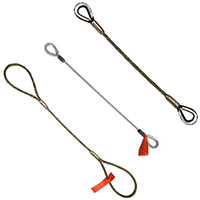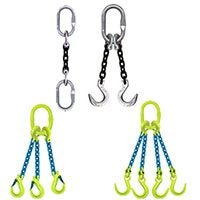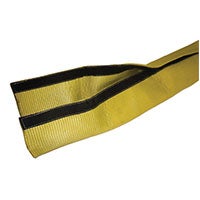Lifting Slings
Subcategories
-
-
Clearance - While Supplies Last!
 1-1/4" x 20' Standard Eye Wire Rope Sling - 6x37 Steel Core Wire Rope
1-1/4" x 20' Standard Eye Wire Rope Sling - 6x37 Steel Core Wire Rope050K-S37/1250X020
-
-
-
Clearance - While Supplies Last!
 1-1/8" x 20' Standard Eye Wire Rope Sling - 6x37 Steel Core Wire Rope
1-1/8" x 20' Standard Eye Wire Rope Sling - 6x37 Steel Core Wire Rope050K-S37/1125X020
-
-
-
Clearance - While Supplies Last!
 1/4" x 5' Standard Eye Wire Rope Sling - 6x25 Steel Core Wire Rope
1/4" x 5' Standard Eye Wire Rope Sling - 6x25 Steel Core Wire Rope050K-S25/0250X005
-
-
-
Clearance - While Supplies Last!
 3/4" x 6' Thimbled Eye Wire Rope Sling - 6x25 Steel Core Wire Rope
3/4" x 6' Thimbled Eye Wire Rope Sling - 6x25 Steel Core Wire Rope050K-S25T/0750X006
-
-
-
Clearance - While Supplies Last!
 3/8" x 14' Thimbled Eye Wire Rope Sling - 6x25 Steel Core Wire Rope
3/8" x 14' Thimbled Eye Wire Rope Sling - 6x25 Steel Core Wire Rope050K-S25T/0375X014
-
-
-
Clearance - While Supplies Last!
 5/16" x 4' Standard Eye Wire Rope Sling - 6x25 Steel Core Wire Rope
5/16" x 4' Standard Eye Wire Rope Sling - 6x25 Steel Core Wire Rope050K-S25/0312X004
-
-
-
Clearance - While Supplies Last!
 7/16" x 10' Standard Eye Wire Rope Sling - 6x25 Steel Core Wire Rope
7/16" x 10' Standard Eye Wire Rope Sling - 6x25 Steel Core Wire Rope050K-S25/0437X010
-
-
-
Clearance - While Supplies Last!
 Crosby 3/8" x 6' Type SSG 1-Leg Grade 100 Chain Sling (Sling Hook / Grab Hook)
Crosby 3/8" x 6' Type SSG 1-Leg Grade 100 Chain Sling (Sling Hook / Grab Hook)078D-GR100SSG375X06
-
-
 Liftex Pro-Edge Polyester Web Sling 1 ply 1" x 2' - Twisted Eyes
Liftex Pro-Edge Polyester Web Sling 1 ply 1" x 2' - Twisted Eyes319-EE1-901X02HT
-
 1" x 10' Double Leg Wire Rope Bridle Sling with 11 Ton Alloy Eye Hoist Hooks
1" x 10' Double Leg Wire Rope Bridle Sling with 11 Ton Alloy Eye Hoist Hooks060-2L1000X10/11TA
-
 1" x 10' Standard Eye Wire Rope Sling - 6x25 Steel Core Wire Rope
1" x 10' Standard Eye Wire Rope Sling - 6x25 Steel Core Wire Rope050K-S25/1000X010
Lifting slings are designed to move large and heavy loads that would be extremely difficult to move manually. We carry three types of lifting slings: wire rope slings, synthetic slings, and chain slings. Wire rope slings, sometimes referred to as wire cable slings or wire rope chokers are more robust and durable than synthetic slings and also have higher temperature limits. However, unlike chain slings they can be difficult to inspect properly. Synthetic slings are lifting slings made from a synthetic material, such as nylon or polyester. Sometimes also referred to as synthetic rigging slings or synthetic lifting straps, these types of slings are lightweight, flexible, and covered with a protective jacket. While they are strong, durable, and great for oddly shaped loads, they should not be used in high-heat applications and are susceptible to cuts and tears. If you are using a synthetic sling on a load with sharp edges that can cut or tear the sling, synthetic sling sleeves, corner guards, or edge guards should be used. Chain slings are industrial lifting slings fabricated from chain. They offer riggers two important advantages over synthetic slings and wire rope slings. Chain slings are more temperature tolerant, cut resistant, and certain options allow chain rigging slings to be adjustable. In addition, a chain sling may be easily repairable depending on the components damaged. As a trade off chain slings can be extremely heavy and more expensive than both wire rope and synthetic slings, and can easily damage loads if not used properly.


























































